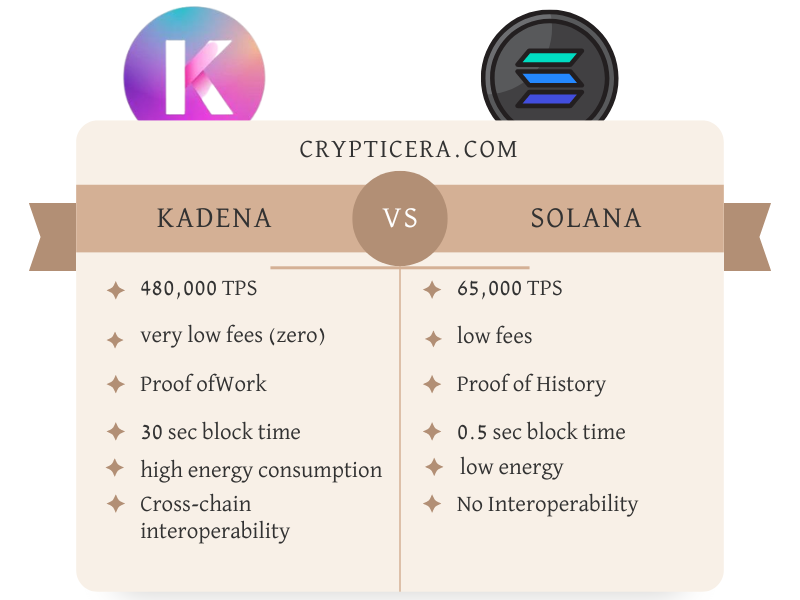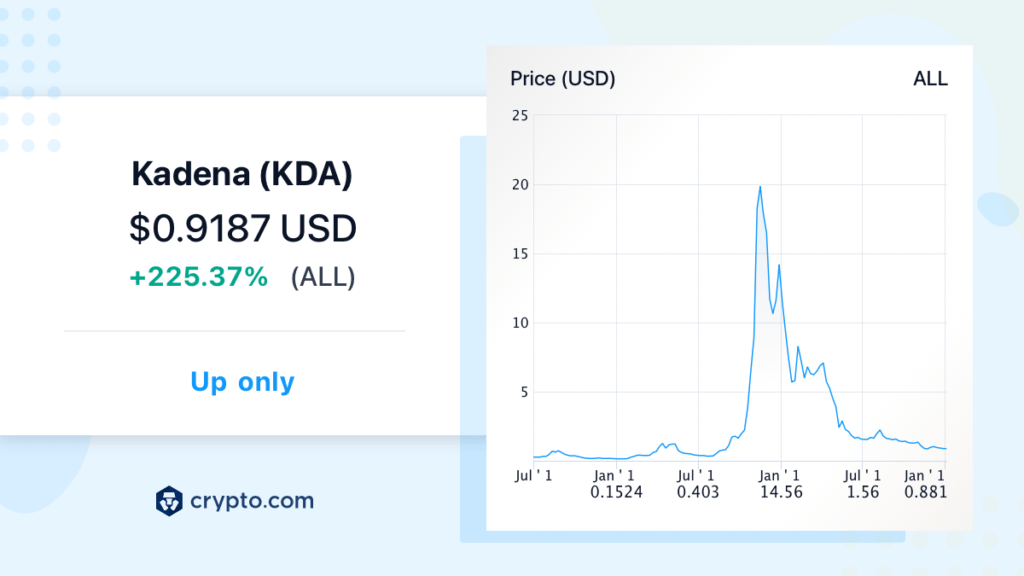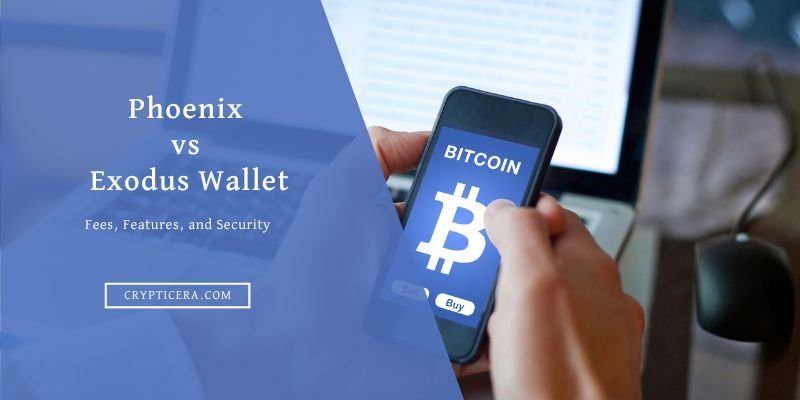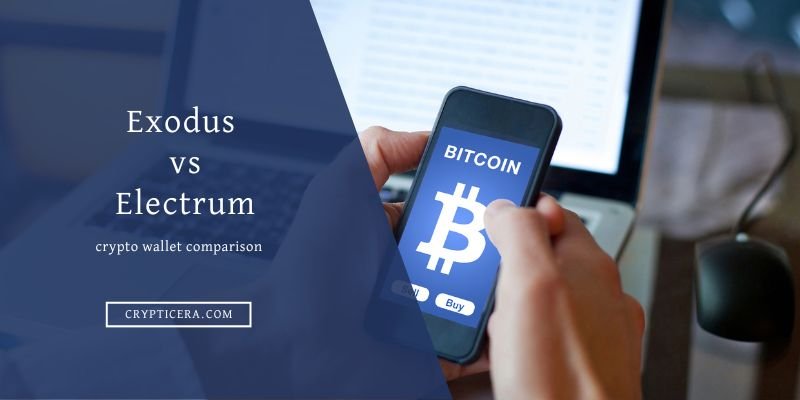Blockchain technology has revolutionized the way we store and transfer data and has the potential to disrupt a wide range of industries.
In the world of blockchain, there are many different platforms to choose from, each with its own unique features and capabilities.
In this article, we will be taking a closer look at two popular blockchain platforms: Kadena and Solana.

Kadena (KDA): A Closer Look
KDA is a cryptocurrency that is used to power the Kadena blockchain, which is a decentralized, public blockchain platform. The Kadena blockchain is designed to be fast, secure, and scalable.
It is intended to be used for a wide range of applications, including financial transactions, supply chain management, and more.
The Kadena team has developed a number of products and services that are built on top of the Kadena blockchain, including a decentralized exchange (DEX) and a smart contract platform.
History and Background
Kadena was founded in 2016 by Stuart Popejoy and Will Martino, who had previously worked together on the development of the Ethereum Virtual Machine.
The company raised $12 million in a seed funding round in 2017 and launched its mainnet in 2019.
Since then, Kadena has attracted a number of high-profile clients and partnerships, including JP Morgan, State Street, and the U.S. Department of Energy’s National Renewable Energy Laboratory.
Blockchain URL: https://kadena.io
Key Features of Kadena
- Hybrid consensus algorithm: Kadena combines proof-of-work (PoW) and proof-of-stake (PoS) for security and scalability
- Pact: It is an energy-efficient proof-of-work (PoW) algorithm
- Chain links: Kadena securely connects multiple private and public blockchain networks
- Scalability: It can able to process more transactions per second than other blockchain platforms
- Energy efficiency: Kadena consumes less energy than other blockchain platforms
- Enterprise-grade: It is an attractive option for enterprise users with its ability to connect with other blockchain networks
- Permissioned: Only approved users can participate in the network, governed by a small group of validators
Solana (SOL): A Closer Look
Solana is a decentralized cryptocurrency that is designed to be fast, secure, and scalable.
It is built on a proof-of-stake (PoS) consensus algorithm and uses a unique architecture that allows it to process thousands of transactions per second.
Solana has a number of features that make it attractive to developers and users. This includes low transaction fees, fast block times, and the ability to run decentralized applications (dApps).
The Solana project is open source and its development is supported by the Solana Foundation.
History and Background
Solana was founded in 2017 by CEO Anatoly Yakovenko and a team of experienced software engineers.
The company raised $20 million in a private funding round in 2018 and launched its mainnet in 2020.
Since then, Solana has attracted a number of high-profile partnerships, including with Chainlink and FTX.
Blockchain URL: https://solana.com
Key Features of Solana
- High transaction speed: Solana can process over 65,000 transactions per second
- Tower BFT: It is a proprietary proof-of-stake (PoS) consensus algorithm
- Anchor: This helps to securely connect to other blockchains, such as Ethereum
- Fast and reliable transactions: Solana is suitable for applications such as decentralized exchanges (DEXs)
- Cross-chain capabilities: This feature allows developers to build applications that connect to other blockchains
- Relatively new platform: It may be seen as less proven and reliable compared to more established platforms
Kadena vs. Solana: Transaction Speed and Scalability
Kadena claims to be able to process up to 480,000 transactions per second on its mainnet. It achieves this through the use of parallel chains. It allows transactions to be processed in parallel rather than in a linear fashion.
Solana claims to be able to process up to 65,000 transactions per second on its mainnet. It achieves this through the use of a novel consensus algorithm called Proof of History (PoH), which allows transactions to be verified and recorded very quickly.
Kadena vs. Solana: Security and Consensus
Kadena uses a hybrid consensus mechanism called Pact, which combines proof-of-work (PoW) and proof-of-stake (PoS) to secure its blockchain.
In the Kadena mainnet, PoW is used to secure the parallel chains, while PoS is used to secure the main chain. This hybrid approach is intended to provide both security and scalability.
Solana uses a novel consensus algorithm called Proof of History (PoH) to secure its blockchain.
PoH is based on a decentralized timestamp server that allows the network to agree on the order in which events occurred, without the need for a central authority.
Solana claims that PoH is more secure and efficient than other consensus algorithms, such as proof-of-work (PoW) and proof-of-stake (PoS).
Kadena vs. Solana: Programming Language
Kadena is written in the programming language Haskell, while Solana is written in Rust.
Note: Pact is a smart contract language that was developed by Kadena and is used on the Kadena blockchain. Kuro is also a programming language used to write custom transaction processing logic in the Kadena platform. However, Kadena itself is written in Haskell.
Haskell is a functional programming language that is known for its strong static type system and expressive type inference.
It is often used for projects that require high levels of security and reliability, such as financial systems and mission-critical applications.
Rust is a systems programming language that is designed to be safe, concurrent, and fast.
It is often used for low-level tasks such as operating system kernels and game engines. Rust has a strong focus on memory safety, and it uses a borrow checker to prevent common programming errors such as null or dangling pointer references.
Kadena vs. Solana: Winner (Which Should You buy?)
| Feature | Solana | Kadena | Winner |
|---|---|---|---|
| Consensus mechanism | Proof-of-History (PoH) | Proof-of-Work (PoW) | Both |
| Scalability | Highly | High | Solana |
| Transaction speed | Very fast (65,000 TPS) | Fast (480,000 TPS) | Kadena |
| Smart contracts | Limited (Rust programming language only) | Full-featured (Pact and kuro) | Kadena |
| Energy Consumption | Very low | high | Solana |
| Governance | Decentralized | Not fully Decentralized | Solana |
| Use cases | Decentralized finance (DeFi), gaming, messaging | Finance, supply chain management | Both |
| Launch date | 2017 | 2017 | – |
| Market cap | $5.13 billion (as of Jan 2023) | $200 million (as of Jan 2023) | Solana |
| Adoption | High | low | Solana |
| Supply | 367,932,725 SOL | 215,466,532 KDA (22% of total) | Solana |
KDA vs. SOL: Token Price Analaysis

On November 11, 2021, Kadena reached its highest-ever value of $28.21. Since then, its value has fluctuated, with a low of $0.790966 and a high of $1.129810. At present, the overall sentiment toward Kadena’s future price is neutral.
There are currently 211.09 million Kadena tokens in circulation out of a maximum supply of 1 billion. The yearly rate of token creation is 26.86%, with 44.70 million Kadena tokens being added in the past year.

Solana reached its highest value on November 6, 2021, reaching an all-time high of $259.52. Since then, the lowest price was $8.09, with the highest being $14.03.
Currently, the sentiment toward Solana’s price prediction is neutral. The current circulating supply of Solana is 362.91 million, with a maximum supply of 533.68 million.
The yearly inflation rate for the supply is 17.34%, meaning that 53.63 million were added in the past year.
In terms of market capitalization, Solana is ranked fifth in the Proof-of-Stake Coins sector, second in the Solana Network sector, and ninth in the Layer 1 sector.
Conclusion
All in all, both Solana and Kadena are serious contenders in the blockchain technology space. Solana’s high scalability and low transaction fees make it attractive for decentralized applications and decentralized finance.
On the other hand, Kadena focuses on security and interoperability Making it ideal for enterprise solutions.
Ultimately the choice between Solana and Kadena will depend on the specific needs and goals of the project.
Both platforms have their own unique strengths, and it will be interesting to see how they continue to evolve and disrupt the industry. future.


